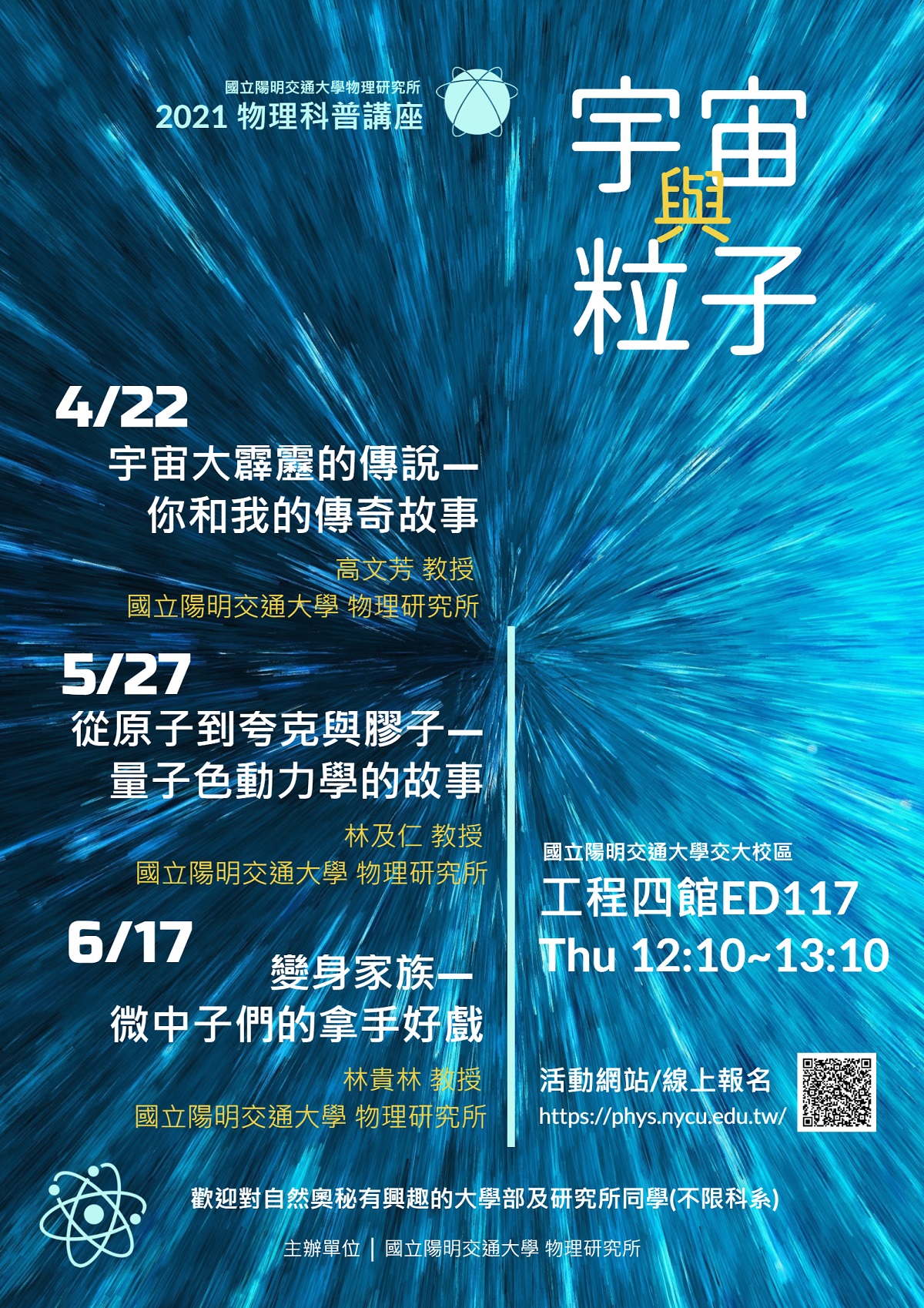10/7 Transfer Matrix Revolutions
時間:10月7日(四) 13:20
題目:Transfer Matrix Revolutions
講者:高英哲 老師
服務單位:國立臺灣大學 物理學系
對象:本所博士生及碩士生、或其他有興趣之師生
地點:採取線上教學,請連結Google Meet: http://meet.google.com/xhy-yotv-wax
時間:10月7日(四) 13:20
題目:Transfer Matrix Revolutions
講者:高英哲 老師
服務單位:國立臺灣大學 物理學系
對象:本所博士生及碩士生、或其他有興趣之師生
地點:採取線上教學,請連結Google Meet: http://meet.google.com/xhy-yotv-wax
時間:4月1日(四) 13:20
題目:夏商周:從神話到史實
講者:郭靜云 教授 Prof. Olga Rapoport
服務單位:國立中正大學 歷史學系
地點:本校科學三館1樓 157室
對象:本所博士生及碩士生、或其他有興趣之師生
郭靜云教授出生於莫斯科,為俄羅斯國家科學院東方研究所博士。
2003年來到臺灣,在故宮博物院、國家圖書館漢學研究中心、中研院歷史語言研究所進行研究;2008年起於中正大學歷史系任教。有30餘年研究、田野考古經驗,擅長透過考古、藝術、文獻、古文字互補考證。2013年出版《夏商周:從神話到史實》一書。
時間:3月25日(四) 11:15-12:15
題目:征服火星的占星大師:克卜勒的新天文學
講者:高崇文 教授
服務單位:中原大學 物理學系
地點:本校科學三館4樓 SC427
對象:本所博士生及碩士生、或其他有興趣之師生
時間:3月25日(四) 13:20
題目:STM/STS Studies of Layered Topological Materials
講者:林俊良 老師
服務單位:國立陽明交通大學 電子物理系
地點:本校科學三館1樓 157室
對象:本所博士生及碩士生、或其他有興趣之師生
4/22
宇宙大霹靂的傳說—你和我的傳奇故事
高文芳 教授 / 國立陽明交通大學 物理研究所
時間:4/22 (四) 中午12:10~13:10
地點:本校光復校區工程四館ED117
6/17 (延期辦理)
變身家族—微中子們的拿手好戲
林貴林 教授 / 國立陽明交通大學 物理研究所
5/27 (延期辦理)
從原子到夸克與膠子:量子色動力學的故事
林及仁 教授 / 國立陽明交通大學 物理研究所
可攜帶外食入場,歡迎邊用餐邊聽演講!!

時間:12月24日(四) 13:20
題目: The First Images of a Black Hole and General Relativistic Magnetohydrodynamical (GRMHD) Accretion/Jet : achievements and challenges
講者:卜宏毅 教授
服務單位:國立臺灣師範大學 物理學系
地點:本校科學三館1樓 110室
對象:本所博士生及碩士生、或其他有興趣之師生
時間:12月17日(四) 13:20
題目:The emergence of collective modes, ecological collapse and directed percolation at the laminar-turbulent transition
講者:施宏燕 研究員
服務單位:中央研究院 物理研究所
地點:本校科學三館1樓 110室
對象:本所博士生及碩士生、或其他有興趣之師生
摘要:
How a laminar flow becomes turbulence has been an unsolved problem for more than a century and is important in various industrial applications. Recently precise measurements in pipe flow experiments showed non-trivial spatiotemporal complexity at the onset of turbulence where lifetime and splitting time of metastable turbulence do not diverge asymptotically as would have been expected in a sharp transition.
Based on numerical evidence from the hydrodynamics equations, we discovered the surprising fact that the fluid behavior at the transition is governed by the emergent predator-prey dynamics of the important long-wavelength mode, leading to the mathematical prediction that the laminar-turbulent transition is analogous to an ecosystem on the edge of extinction. This prediction demonstrates that the laminar-turbulent transition is a non-equilibrium phase transition in the directed percolation universality class, and provides a unified picture of transition to turbulence emerging in systems ranging from turbulent convection to magnetohydrodynamics.
Reference:
[1] Hong-Yan Shih, Tsung-Lin Hsieh and Nigel Goldenfeld, Nature Physics 12, 245 (2016)
[2] https://www.nature.com/collections/rxsztdqblr
時間:12月 10日(四) 13:20
題目:ANITA極高能微中子實驗中所發現的反常事例
講者:劉宗哲 老師
服務單位:國立交通大學 電子物理學系
地點:本校基礎科學教學研究大樓1樓 110室
對象:本所博士生及碩士生、或其他有興趣之師生
摘要:
We report on an upward traveling, radio-detected cosmic-ray-like impulsive event with characteristics closely matching an extensive air shower. This event,
observed in the third flight of the Antarctic Impulsive Transient Antenna (ANITA), a NASA-sponsored long-duration balloon payload, is consistent with a similar event reported in a previous flight.
These events may be produced by the atmospheric decay of an upward-propagating τ-lepton produced by a ντ interaction, although their relatively steep arrival angles create tension with the standard model (SM) neutrino cross section.
Each of the two events have a posteriori background estimates of <∼ 10^{−2} events.
If these are generated by τ-lepton decay, then either the charged-current ντ cross section is suppressed at EeV energies, or the events arise at moments
when the peak flux of a transient neutrino source was much larger than the typical expected cosmogenic background neutrinos.
https://arxiv.org/pdf/1803.05088.pdf

多元領域與人才
特色發展之實驗室及專精領域
嚴謹之課程架構以培養學生具研究能力
積極培養學生具國際化素養及視野
地址:30010 新竹市大學路1001號
電話:03 572 0810
傳真:03 572 0728
信箱:f641126@nycu.edu.tw
lcchen@nycu.edu.tw
